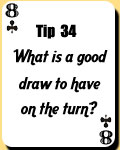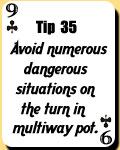What is good draw to have on the turn?
Drawing here would mean a hand needed to improve to win. That is, although a hand such as a two pair  or a set could improve to make a full house, it would typically be able to win the pot without further improvement.
or a set could improve to make a full house, it would typically be able to win the pot without further improvement.
The best draw would be a poker hand that would need one card to make a flush and also were to be an open-ended straight, especially if you could win the pot merely by making a pair. For example, if the board were to show a two, a three, a ten, and a jack, two of which were diamonds, and you were holding a king of diamonds, and a queen of diamonds, a considerable number of cards would make yours the best hand.
You would have nine flush outs, plus six additional straight cards. In addition, the six remaining kings and queens could make you a winner. This would mean that twenty-one of forty-four unseen cards would potentially help your hand, or nearly fifty percent of the remaining cards.
Draws wouldn’t get any better than this, and it would be correct to raise with this hand for value if there were a bet and a few callers. Of course, the more poker players who were to be in the pot, the less likely that simply making a pair of kings or queens would be enough to win. That loss of outs would be compensated by the increased payoff for making a straight or flush.
Other good quality draws would include flush draws (nine outs), mainly to the nut flush, and open-ended straight draws (eight outs).
Note: Here is a word of caution about straight draws. If a flush were to be already possible, you could be drawing dead, or at the very least would have lost two of your wins (as these cards would put a four-card flush on the board). So, as a general rule, it would be erroneous to draw to a straight when a flush was already possible.
Also, the sheer presence of a flush draw would lessen the value of straight draws, as you would be faced with the possibility that twenty-five percent of the cards that would fill your straight could make someone else a flush. Gambling Guide. If two flush draws were to be on the poker board, only half your outs would be totally “clean.” This is often enough to make folding the correct play, unless the pot were to be very large.
Avoid numerous dangerous situations on the turn in multiway pots.
This tip recognizes and discusses common situations that could burn up your chips if you won’t be careful. We hope it will allow you to navigate better through some rough waters. These points concern multiway pots, those involving four or more poker players.
We hope it will allow you to navigate better through some rough waters. These points concern multiway pots, those involving four or more poker players.
Playing Second Pair When Someone Bets
In a pot with several poker players, one of who were to be betting, it would usually take more than second pair to get the money. So, you should throw this hand away. You would have only five cards to improve (meaning only about one in nine times would the river card rescue you), and there would be no assurances that even making two pair or trips would be enough. Your two-pair card could make someone else a straight or a flush.
Staying in With Top Pair When Others Are Betting and Raising
When you were to be holding top pair on the flop, an overcard were to come on the turn, and someone else were to bet, most of the time this action would be an sign that you just got outdrawn. Assuming this were the case, you would now be left with second pair, comparable to the first example in this tip. It would be no fun, but you must usually give up your hand in a multiway pot when this was to happen. You would save money in the long run by doing so –and that would be more fun than losing the money.
Drawing at a Straight when a Flush Is Already Possible
Suppose the board were to show a four, a five, a ten, and a jack with three hearts. You were holding a king of clubs and queen of clubs. Not only would you have an open-ended straight draw, you would have two overcards. Game of Cards. Though, life wouldn’t exactly be rosy. For one thing, you could be drawing dead already. If not, at least one of your several poker rivals would certainly have a heart in his hand.
This would mean you might make either a straight or a pair, but would still lose the pot if the card would also put a four-flush on the board. Therefore, of your fourteen potential outs (assuming you were even drawing live), only ten of them would be ‘clean,’ and it could be a stretch to think merely making a pair would be enough.
Drawing at a Straight or Flush when the Board is Paired and There is a lot of Action
Once again, we stress that drawing at one hand when a stronger one is possible could be a recipe for disaster. The more poker players in the hand, the more likely it would be that someone might have a full house already. You wouldn’t be giving anything up if you were to choose not to draw at straights and flushes when the board was to be paired in a multiway pot.
A further concern here would be which pair was present on the board. If the paired card was one that people would tend to play (aces, and to a slightly lesser extent, any face card), then it would be more likely that someone would have trips or better. Also, straight draws could be particularly unsafe here, as a poker player holding trips would be likely to have another card in the same neighborhood.
For instance, if the board was to show a pair of jacks, a queen, and a three and you were to have a king and a ten, your straight card could make someone a full house. It would be logical that you might be against a queen and a jack, a jack and a nine, or an ace and a jack. Against the first, you would be drawing dead; against the other two, you would be drawing very slim, because in each case one of your straight cards would make a full house for your poker opponent.
Betting and Getting Raised by a Very Tight Player
If this were to happen, you would be in a world of trouble if you weren’t holding the nuts. With some hands, you would have enough to call. These would include small straights, flushes, or two pair when the poker board wouldn’t show a straight or flush.
About the only non-nut hand worth a re-raise would be a small or medium set, when the board wouldn’t contain ‘pat hand’ possibilities. The reason for this would be that the tight poker player could have a pair of aces or a pair of kings, hands you could beat with your set.
